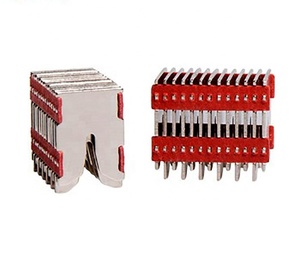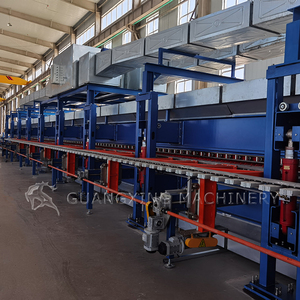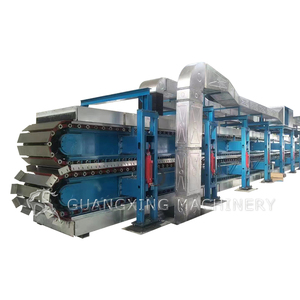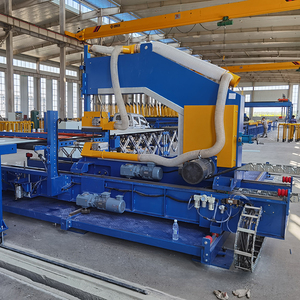
All categories
Featured selections
Trade Assurance
Buyer Central
Help Center
Get the app
Become a supplier

(11493 products available)












There are various systems for assembly line automation. Every kind of assembly line automation is meant for specific tasks and industry requirements. The systems range from simple mechanical systems to complex computer-controlled robotics.
These systems play a crucial role in improving the efficiency of production lines in various manufacturing industries. They help businesses achieve higher output, reduce labor costs, and remain competitive in the market.
This is the most basic of all the assembly line automations. Most of the work is done by hand, though some tools aid speed and efficiency. Manual assembly lines are flexible. Businesses in producing complex or custom products like electronics or automotive parts find this automation ideal.
Mechanical automation involves using machines that are solely operated by mechanical devices. These machines perform simple tasks like conveying, screwing, or welding. Mechanical automation does not require programming or control based on computers. This makes it easy to operate and maintain, especially in businesses that do not require complex operations.
This kind of automation is ideal for production processes that need frequent changes. It entails using programmable devices such as PLCs to control the assembly line. These systems are reprogrammable. This feature makes it easy to adapt to new products or processes without major overhauls of the system.
Industrial robotics automation utilizes robotic arms to perform assembly tasks. The tasks that can be achieved using these robots are: welding, painting, assembly, and material handling, to mention a few. The robots are controlled by computer programs that dictate their movements and actions.
Robotics automation can be used in any production process. However, it is most useful in processes that require precision and consistency. Industries like automotive, electronics, and aerospace prefer robotic automation due to its efficiency in mass production.
This type of automation combines different forms of automation. Examples are mechanical, programmable, and robotic automation. Hybrid automation systems are flexible to cater to the diverse needs of modern manufacturing. A manufacturing firm can use mechanical automation for routine tasks. Meanwhile, they will employ robotic or programmable automation for more complex assemblies. Hybrid systems are ideal for industries that produce a wide range of products or have variable production demands.
Businesses are increasingly adopting assembly line automation to improve commercial value. This increase is regardless of the cost that one incurs to install these systems. Below are ways businesses benefit from automated assembly lines.
Assembly line automation helps to streamline the manufacturing process. They reduce the time taken to produce an item. Most of these systems work continuously. This means there are no breaks as it would be if humans were running the production. Such speed and consistency lead to high output rates.
As mentioned, automated lines are designed to be fast and work continuously. That means they can produce products at a higher rate than manual assembly lines. In 24 hours, a fully automated assembly line can produce more than a manual line decreases.
The risk of human error in production is significantly reduced with automation. Automated assembly lines use machines and robots to carry out a task. This, therefore, ensures consistency in the production of their products. This consistency is vital in improving product quality. It reduces defects, rework, and scrap rates.
Moreover, many automated systems have quality control built into the process. These are usually sensors and cameras that detect defects in real time. This automatic inspection allows for instant corrections. It also minimizes the number of defective products reaching the market.
Labor costs contribute to the high operating costs of any business. However, automating assembly lines reduces labor costs by eliminating the need for many manual workers. As discussed before, fully automated assembly lines have a low need for human labor. There can be a reduction in labor force by up to 80% with these lines.
Furthermore, automated systems are designed for efficiency. They help reduce the energy consumed by the production lines. That means lower utility bills. In this era of sustainability, lower energy consumption can help reduce the carbon footprint. This will, in turn, improve a company's social responsibility.
Programmable and robotic automations can be quickly reconfigured for different products. This flexibility is essential for manufacturers dealing with diverse product lines or fluctuating market demands. Automated systems can be easily adjusted for new product designs or changes in production requirements. This adaptability helps manufacturers respond quickly to market trends and customer needs.
Despite the high initial costs of implementing assembly line automation, the long-term benefits often result in a significant ROI. Reduction of labor and production costs means, eventually, the business will break even and even make profits. Moreover, with increased efficiency and product quality, there will be an increase in sales and market share. Hence, automation will make the company better off financially and competitively in the market.
Assembly line automation prices are not the same for all cases. Many factors will contribute to this variance. Below are some of them.
As discussed, different kinds of assembly line automation serve distinct purposes. For instance, mechanical automation is less complex than robotic or programmable automation. Of course, simpler systems will be cheaper to install. Complicated systems with industrial robots and advanced sensors and software will require customers to dig deeper into their pockets.
Mechanical automation is the cheapest of all automation systems. This is because it involves simple machines that require little to no programming. Next is programmable automation. These systems are moderately priced due to their need for programmable devices. The most expensive of all are robotic and hybrid automation systems. These systems involve the costs of robotic arms, sensors, and complex control systems.
This factor has a direct impact on the pricing of assembly line automation. Off-the-shelf automation solutions are cheaper as they are pre-manufactured components. Custom automation solutions are expensive because they are tailored for the buyer's specific needs. They will, therefore, consider the unique requirements of the production process and environment.
Imagine automation systems with the latest technology in software and equipment. These systems will be more expensive than those using older systems. For instance, incorporating Industry 4.0 technologies such as IoT and AI into automated systems will increase the price. However, these new features can boost performance, efficiency, and scalability.
The integration and installation costs will be less if the automation system integrates seamlessly with existing production processes. The more incompatible the system is, the more costs it will take to integrate and install it. There will also be induction training for the employees and other associated costs.
Considering long-term maintenance and support costs, there will be more expenses in the robotic and hybrid automation systems. Mechanical and manual systems require less maintenance. The basic form of assembly line automation uses mechanical components, after all.
The selection process involves assessing several factors. These factors will help identify the best assembly line automation for the client's business needs.
The first thing to consider is the nature and volume of production. Such form factors will also help determine the best system for the client. Large-scale productions benefit the most from robotics and mechanical automation. There is more efficiency and consistency in these systems. Low-volume productions prefer manual or customizable systems. These systems are easier to reconfigure for different products.
The type of product will play a role in deciding the automation systems. Industries are producing complex products like electronics or automobiles. Such industries will require robotic or programmable automation for their production process. Mechanical and manual automation will suffice in industries producing simpler products. These products could be assembling structures or inserting parts.
As we have seen, the costs of assembly line automation vary widely. They depend on the complexity and type of system. Managing customers' budgets will be important in selecting suitable automation. One can recommend cost-effective solutions like mechanical or manual automation. These systems will stay within the required budget. If there are long-term savings and efficiency are the main concern, the client has to consider investing in robotic or hybrid automation systems. They will achieve them in the long run.
How adaptable the chosen automation system should be must be considered. This adaptability will ensure that systems can be quickly reconfigured. They can be used for new products or different production processes. Such features will help the client respond to changing market demands and business conditions. Automation systems with scalability can easily accommodate production volume increases. This makes them ideal for growing businesses.
If clients go for complex automation systems, they will need technical expertise to operate and maintain them. Businesses have to consider the level of training that will be required for the current staff. These staff have to program, operate, and fix the new systems, and they may not easily have the expertise. They might need induction training. If a business's personnel do not have the skills to operate the automation, they might have to hire new staff who know their way around the systems. After all, they have to maintain these systems.
Assembly line automation reduces production time and increases the output rate. Automated assembly lines can work continuously without breaks. It makes them more efficient than manual processes. Results indicate that automated lines can produce more units in a given time than manual lines.
Six factors should be considered. They are nature and volume of production, type of product, budget, technical expertise, scalability, and flexibility.
Yes, assembly line automation can be integrated into existing manufacturing processes. Especially if the current systems are compatible with the new automation. Installation and integration costs can be reduced by choosing systems that easily fit into the existing infrastructure.
The long-term benefits are cost savings, improved product quality, and increased production capacity, to name a few. Automating the assembly lines helps reduce labor costs. There will be more consistency in the products, and we all know the more products, the better for business.
Robotics is among the most vital roles in assembly line automation. They perform tasks like welding, painting, and assembling. Most importantly, robotic systems are highly precise and can work continuously without getting tired. This makes them ideal for high-volume production processes.